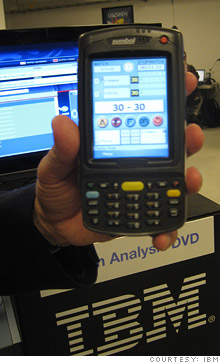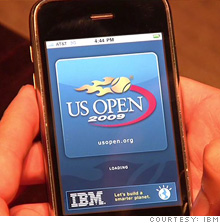Behind the scenes at the U.S. Open
Underneath one of the U.S. Open's main events lies a treasure trove of tennis information that travels around the country in seconds to keep millions of fans up to date.
 |
| The chair umpires use this device to keep score -- and update millions of fans instantly. |
 |
| About 60 IBM and USTA techies work the control room to keep the enormous amounts of data flowing smoothly. |

NEW YORK (CNNMoney.com) -- With more than 250 men and women vying for the U.S. Open championship, it's a wonder that each and every ace (and fault) is seamlessly shown on the scoreboard, your iPhone, and online.
How'd they do that?
It all starts with the click of just one button. But it gets much more complicated -- involving data taking a cross-country tour from the ump's chair to your cell phone (or whatever device you're watching).
The U.S. Open tennis tournament is the world's biggest sporting event of the year, with more than 700,000 fans expected to pass through the gates of the Billie Jean King National Tennis Center in Queens, N.Y., this year.
The two-week competition, which began Aug. 31, is even more popular outside the comfy confines of Arthur Ashe Stadium. The U.S. Tennis Association estimates that more than 300,000 spectators will watch the games live online at usopen.org, with more than 10 million additional tennis buffs accessing the scores on the Internet or checking updates on their mobile phones.
So when top-ranked Roger Federer (who won the Open last year) faces a match point, millions of fans around the world are on the edge of their seats, even if they're not in the stadium.
That's where the IBM (IBM, Fortune 500) comes in -- by providing the technological guts of the operation for the past 18 years.
From court to computer. In the bowels of the tennis center underneath the Louis Armstrong Stadium lies the digital media control room, where dozens of IBM and USTA techies monitor the Web site, check server requests and keep the show running.
It works like this: IBM provides every chair umpire with a PDA device that lets the ump record a point by clicking on a box either on the left side or right side of the screen. The device also lets the umpire record an ace, a fault, a foot foul or note when a player challenges a call.
As soon as the ump clicks a button, the information is instantly sent to a massive database that contains every statistic for every game. USTA statisticians on the sidelines also have computers and enter information like unforced errors, net shots and first-serve percentages that get uploaded to the database.
The data is hosted by three IBM servers located in different parts of the country, which communicate with one another to spread out data requests and prevent overloads. Those servers provides instant access to every imaginable statistic across all kinds of media.
Users can access the scores and other information on the Internet at usopen.org or at other sites that buy the data, like si.com, espn.com and yahoo.com. They can do the same with the new U.S. Open iPhone application.
If a television producer wants to display how many double faults a player has scored during a match, the producer can simply click a button in the TV truck that says "double faults," and a graphic will pop up on TV.
The technology helps television announcers, too. Although former tennis star John McEnroe sounds like he holds an encyclopedia of tennis knowledge in his head when he provides color commentary on ESPN and CBS, he gets a lot of help from assistants who can look up stats at the touch of a button.
The stats are also used for the spectators at the game, with scores and draw information constantly updated and displayed prominently at the event.
But the greatest benefit may be for the players and coaches. At the end of the tournament, IBM sends DVDs of the matches to the players. Since all of the statistics are date-stamped, the DVD allows players to drill down into their matches to view specific events. For instance, a player can watch all of their unforced errors, winners and returns to study their tendencies and improve their play.
Have you suffered a setback because of the economy? What are you doing to overcome it and get back on track? If you've been confronted with some challenge during this recession but are fighting back, send an email to realstories@cnnmoney.com and you could be profiled in an upcoming segment on CNN. For the CNNMoney.com Comment Policy, click here. . ![]()

